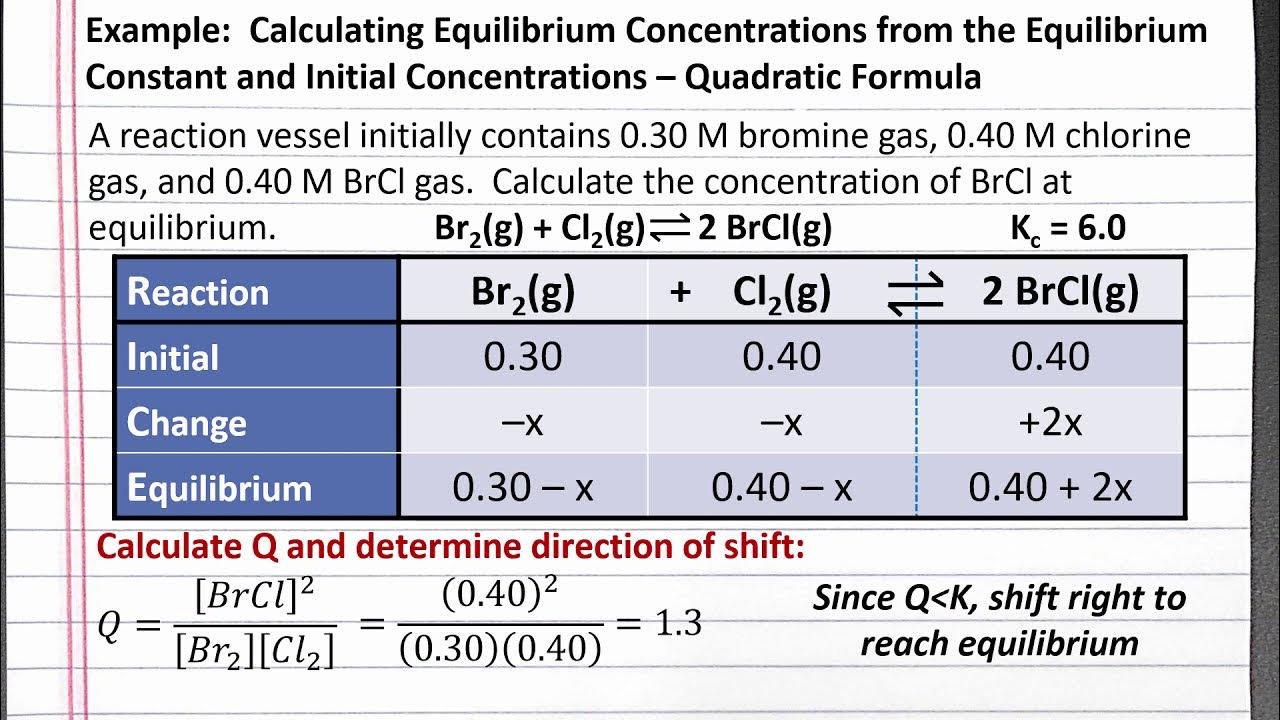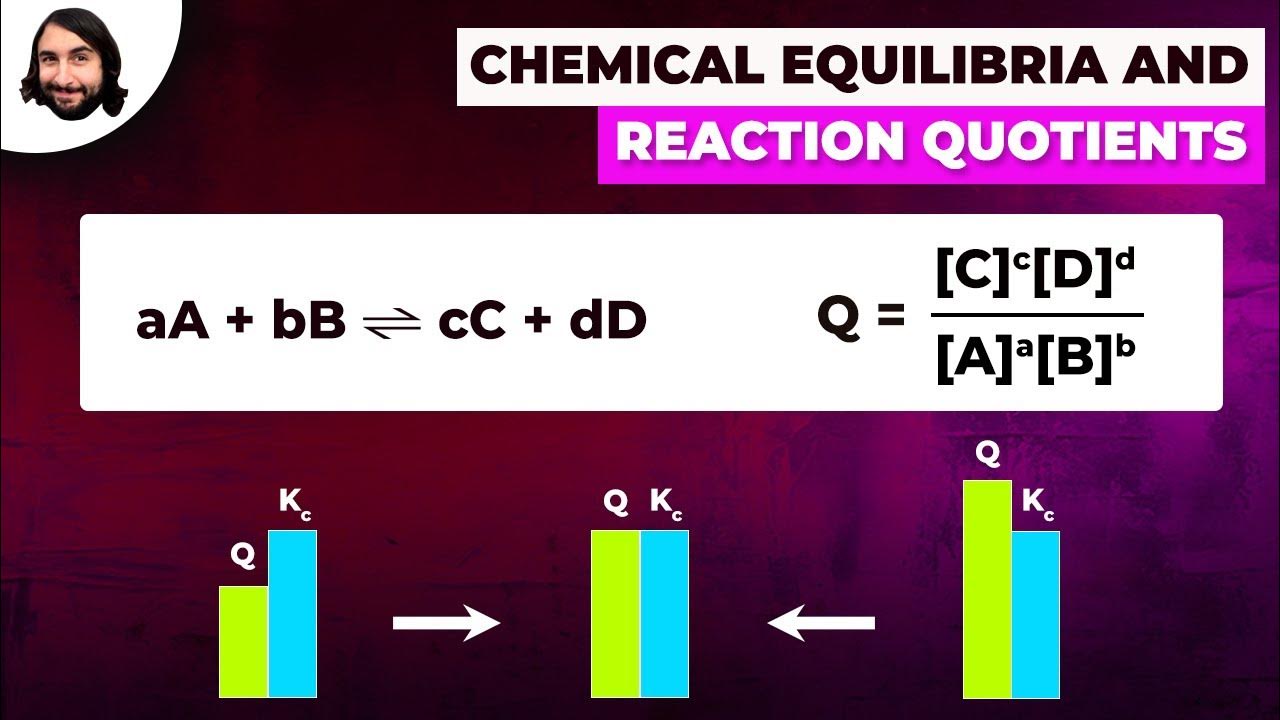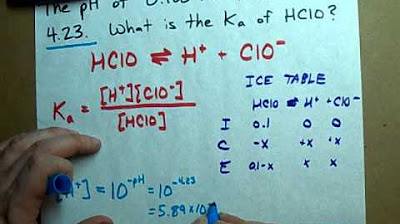Equilibrium Problems #1
TLDRThe video script presents a method to determine equilibrium concentrations in a chemical reaction using an ICE (Initial, Change, Equilibrium) table. The example involves synthesizing iodine monochloride from iodine and chlorine, with initial amounts of reactants given and the equilibrium constant (K_eq) provided. The ICE table is constructed to track changes in concentrations, starting from initial values to equilibrium. The video demonstrates how to use the K_eq expression to solve for the unknown variable 'X', representing the change in concentration. By substituting the equilibrium concentrations back into the K_eq expression, viewers can verify their calculations. The process is explained step by step, emphasizing the importance of careful manipulation of the equations to solve for 'X' and ultimately find the equilibrium concentrations of all species involved in the reaction.
Takeaways
- 🧪 Use an ICE (Initial, Change, Equilibrium) table to solve for equilibrium concentrations when they are not given.
- 🔍 Start by filling in the initial concentrations of reactants and products based on the amounts added to the system.
- ⚖️ Calculate initial concentrations by dividing the number of moles by the volume of the container.
- ➡️ Recognize that the reaction will shift towards the product since ICl starts at zero concentration.
- 📉 The concentrations of reactants will decrease by an amount represented by 'X', while the product's concentration will increase by '2X'.
- 📏 Use the equilibrium constant (Keq) expression to solve for 'X' when equilibrium concentrations are not provided.
- 🔢 Substitute the equilibrium expressions into the Keq formula and solve for 'X', taking care to handle the algebra correctly.
- ✅ After finding 'X', use it to calculate the equilibrium concentrations of all species involved in the reaction.
- 📊 The equilibrium concentrations can be checked by substituting them back into the Keq expression to verify the result.
- 📚 Practice using the ICE table method with different problems to reinforce understanding and improve problem-solving skills.
- 🔗 Remember to keep track of units throughout the calculation process, as they are crucial for accurate concentration values.
Q & A
What is the balanced chemical equation for the reaction discussed in the video?
-The balanced chemical equation for the reaction is the synthesis of iodine monochloride (ICl) from iodine (I2) and chlorine (Cl2).
What are the initial amounts of iodine and chlorine placed in the flask?
-The initial amounts are 0.2 moles of iodine and 0.2 moles of chlorine.
What is the volume of the flask used in the experiment?
-The volume of the flask is 5 liters.
What is the equilibrium constant (K_eq) for the reaction at the given temperature?
-The equilibrium constant (K_eq) is given as 81.9 at the specified temperature.
What is an ICE table and how is it used in this context?
-An ICE table is a method used to calculate equilibrium concentrations in a chemical reaction. It stands for Initial, Change, and Equilibrium. It helps to systematically determine the concentrations of reactants and products at equilibrium.
How are the initial concentrations of iodine and chlorine calculated?
-The initial concentrations are calculated by dividing the number of moles by the volume of the container, resulting in 0.0400 moles per liter for both iodine and chlorine.
In the ICE table, what is the change in concentration represented by 'X'?
-In the context of the ICE table, 'X' represents the change in concentration of the reactants and products as the reaction proceeds towards equilibrium.
How is the equilibrium constant expression (K_eq) used to solve for 'X'?
-The equilibrium constant expression is used by substituting the equilibrium concentrations, which are in terms of 'X', into the K_eq formula. This allows for the formation of an equation that can be solved for 'X'.
What is the value of 'X' that is calculated in the video?
-The value of 'X' calculated in the video is 0.0328 moles per liter.
What are the equilibrium concentrations of iodine (I2), chlorine (Cl2), and iodine monochloride (ICl)?
-The equilibrium concentrations are 0.0072 M for I2 and Cl2, and 0.0656 M for ICl.
How can you check if the calculated equilibrium concentrations are correct?
-You can check the calculated equilibrium concentrations by substituting them back into the K_eq expression to see if the result is close to the given K_eq value of 81.9.
What is the recommendation for further practice after understanding the ICE table method?
-The video suggests attempting problem number 52 on page 451 for additional practice, which involves using the K_eq expression to solve for 'X'.
Outlines
🧪 Introduction to ICE Table for Equilibrium Concentrations
This paragraph introduces the use of an ICE (Initial, Change, Equilibrium) table to solve for equilibrium concentrations when they are not provided in a chemical problem. The problem involves synthesizing iodine monochloride from iodine and chlorine, with initial amounts of iodine and chlorine given, as well as the equilibrium constant (keq). The ICE table is constructed to find the concentrations of reactants and products at equilibrium, starting with initial concentrations and calculating the changes that lead to equilibrium concentrations. The process uses the given keq value to solve for the unknown variable X, which represents the change in concentration.
🔍 Solving for X Using the Equilibrium Constant Expression
In this paragraph, the video script explains how to use the equilibrium constant (keq) expression to solve for the unknown concentration change, represented by X. The keq is provided, and the concentrations at equilibrium are expressed in terms of X. By substituting these expressions into the keq formula, the video demonstrates how to isolate and solve for X, avoiding the complexity of dealing with squared terms by taking the square root of both sides of the equation. The solution process is detailed, emphasizing the importance of careful manipulation and the option to use additional digits for increased accuracy in calculations.
📝 Calculating Equilibrium Concentrations and Verifying with keq
The final paragraph details the calculation of equilibrium concentrations for iodine (I2), chlorine (Cl2), and iodine monochloride (ICl) using the value of X determined previously. It shows how to find the equilibrium concentrations by subtracting X from the initial concentrations of I2 and Cl2 and calculating 2X for ICl. The paragraph also suggests a method to check the work by substituting the calculated equilibrium concentrations back into the keq expression to verify if the result matches the given keq value. This serves as a validation step to ensure the calculations are correct. The video concludes by encouraging viewers to attempt a related problem, number 52 on page 451, which requires using the keq expression to solve for X.
Mindmap
Keywords
💡Equilibrium concentrations
💡ICE table
💡Balanced equation
💡Initial conditions
💡Equilibrium constant (Keq)
💡Mole concept
💡Volume of the container
💡Concentration
💡Coefficients
💡Change in concentration
💡Checking work
Highlights
The video demonstrates how to use an ICE table to solve for equilibrium concentrations when none are given.
The reaction involves synthesizing iodine monochloride from iodine and chlorine.
Initial amounts of iodine and chlorine are 0.2 moles and 0.2 moles, respectively, in a 5-liter flask.
The equilibrium constant (K_eq) is given as 81.9 at the specified temperature.
An ICE table is constructed to keep track of initial, change, and equilibrium concentrations.
Initial concentrations of iodine and chlorine are calculated to be 0.0400 M.
Since no ICl is initially present, its concentration starts at 0 and will increase.
The reaction will shift to the right due to the absence of ICl at the start.
The equilibrium concentrations are unknown, requiring the use of K_eq to solve for X.
K_eq expression is rearranged to solve for the change in concentration (X).
The numerator and denominator are both squared, simplifying the equation to solve for X.
X is solved to be 0.0328 M, which is the change in concentration for iodine and chlorine.
The equilibrium concentrations of iodine and chlorine are calculated to be 0.0072 M.
The equilibrium concentration of ICl is found by multiplying X by 2, resulting in 0.0656 M.
The ICE table is a helpful tool for visualizing and solving equilibrium problems.
Substituting the calculated concentrations back into the K_eq expression can verify the results.
The video provides a practical example of how to handle equilibrium problems without given concentrations.
The method can be applied to similar problems, as demonstrated by the suggestion to try question 52 on page 451.
Transcripts
Browse More Related Video

CHEM 201: Calculating Equilibrium Concentrations from K and Initial Values – Quadratic Formula

Chemical Equilibria and Reaction Quotients

Using RICE to calculate equilibrium concentrations

Practice Problem: ICE Box Calculations

Equilibrium

Find the Ka of an acid (Given pH) (0.1 M Hypochlorous acid) EXAMPLE
5.0 / 5 (0 votes)
Thanks for rating: